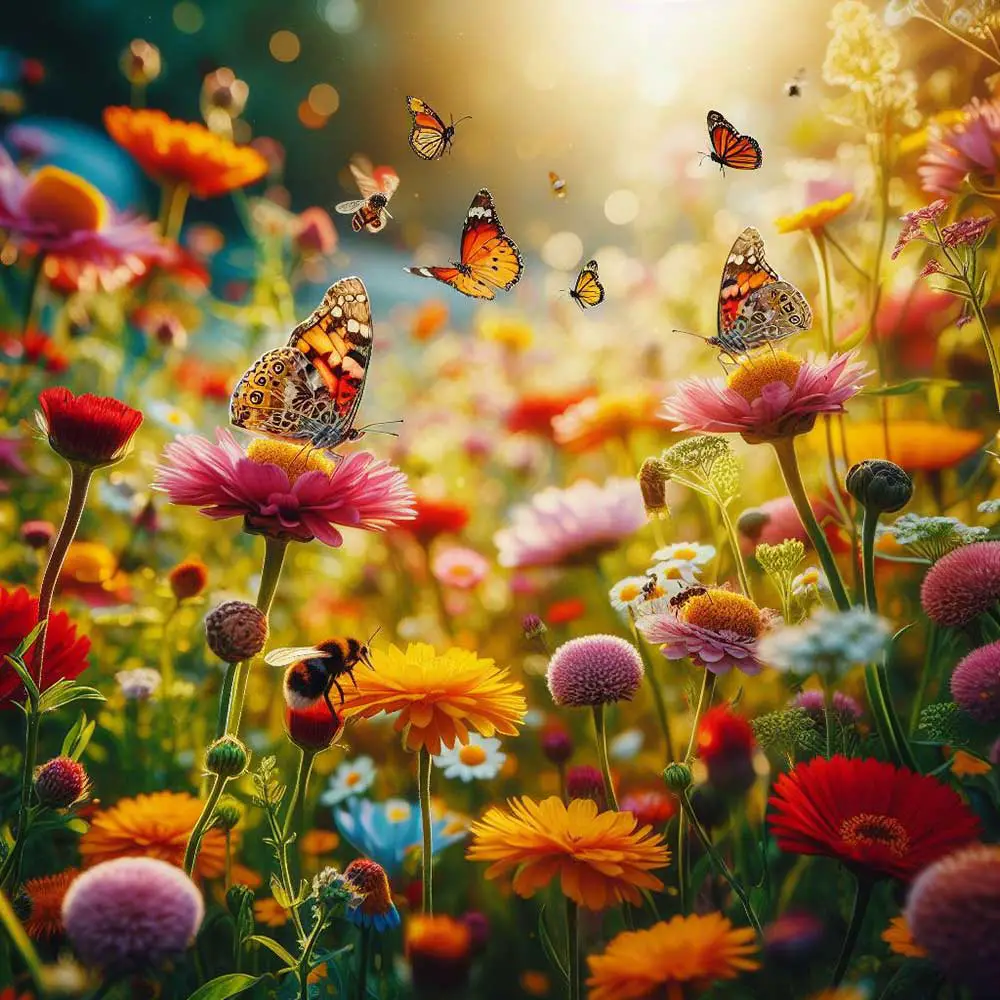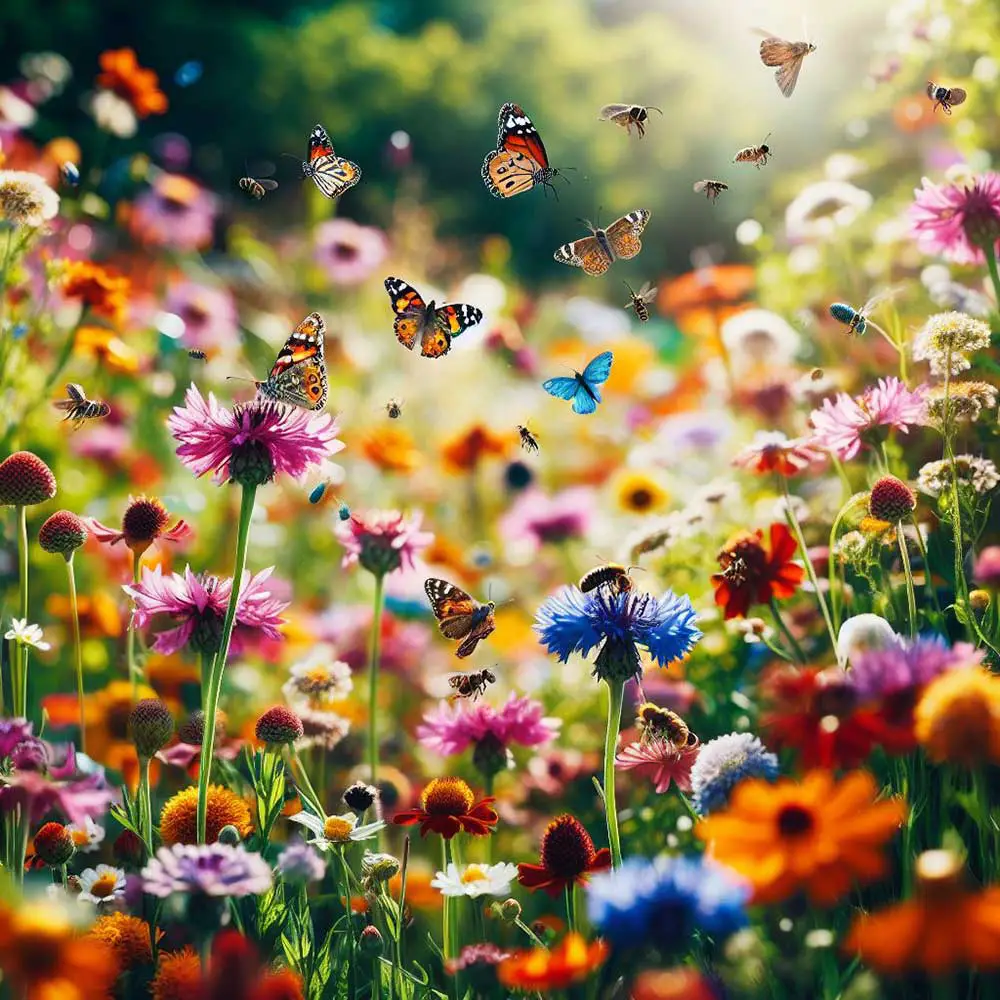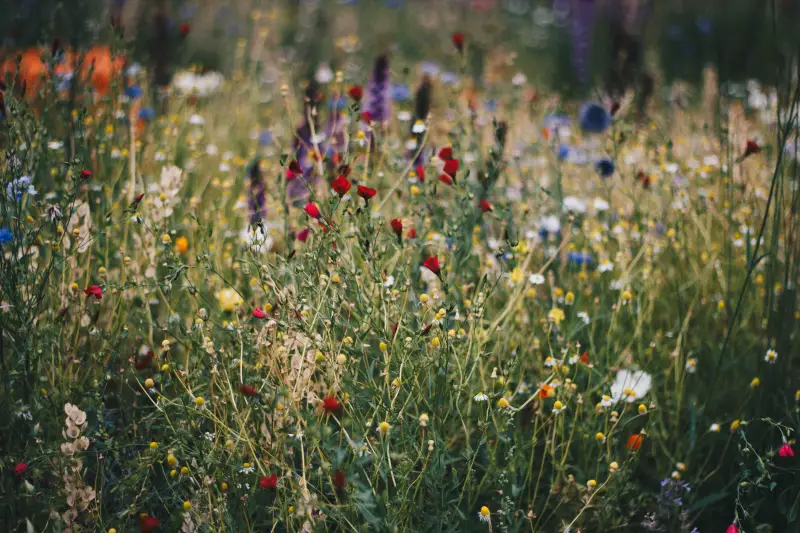As you gaze upon a barren field, your eyes yearn for a burst of life, a vibrant tapestry of colors that only wildflowers can provide.
But how long, you wonder, does it take for these delicate blooms to grace the landscape?
With your curiosity piqued, let us explore the intricate process of wildflower growth, and discover the factors that influence their journey from seed to bloom.
How Long For Wildflowers To Grow?
Wildflowers typically take several weeks to several months to fully grow and bloom, depending on the specific species and environmental conditions. The growth process of wildflowers can be divided into several stages: germination, vegetative growth, and flowering.
Germination is the first stage of growth, where the seed sprouts and develops into a seedling. This process can take anywhere from a few days to a few weeks, depending on the species. Factors such as temperature, moisture, and light conditions play a crucial role in determining the speed of germination.
Once the seedling emerges, it enters the vegetative growth stage. During this phase, the plant focuses on developing its roots, stems, and leaves. This growth period can last anywhere from a few weeks to a few months. Adequate sunlight, water availability, and nutrient-rich soil are essential for healthy vegetative growth.
Seed Size And Depth
The size and depth of the seeds play a crucial role in the successful growth and establishment of wildflowers. When it comes to seed size, bigger doesn’t always mean better. In fact, the size of the seed is directly related to the size of the plant it produces. Smaller seeds, like those of daisies or forget-me-nots, typically produce smaller plants, while larger seeds, like those of sunflowers or cornflowers, produce larger plants.
In terms of seed depth, it’s important to strike the right balance. Planting the seeds too shallow can expose them to predators or dry out quickly, while planting them too deep can prevent them from receiving enough sunlight for germination. As a general rule of thumb, wildflower seeds should be planted at a depth that’s roughly three times their own diameter. This helps to ensure that they’ve enough moisture, warmth, and protection from potential threats.
When sowing wildflower seeds, it’s also important to consider the type of soil. Some seeds require direct contact with the soil, while others can germinate even when covered with a thin layer of mulch. Understanding the needs of the specific wildflower species and providing the right conditions for seed size and depth will greatly increase the chances of successful growth and establishment.
Lawn Status
To assess the success of growing wildflowers, it’s important to evaluate the current status of your lawn. The condition of your lawn plays a crucial role in the growth and development of wildflowers. Before sowing the seeds, take a close look at your lawn to determine its health and suitability for wildflower growth.
Start by examining the soil composition. Wildflowers thrive in well-drained soil that’s rich in organic matter. Conduct a soil test to determine the pH level and nutrient content. Adjust the pH if necessary and add organic matter to improve soil fertility. It’s also important to remove any weeds or invasive plants that may compete with the wildflowers for resources.
Next, assess the sunlight availability in your lawn. Most wildflowers require at least six hours of direct sunlight each day to flourish. Observe the different areas of your lawn throughout the day to identify areas that receive sufficient sunlight and those that are shaded. Consider planting shade-tolerant wildflower species in areas with less sunlight.
What Month Is Best To Plant Wildflower Seeds?
The ideal month to plant wildflower seeds depends on your location and climate, as different regions have different growing seasons. To determine the best month for planting, it’s important to consider factors such as average temperatures, frost dates, and rainfall patterns in your area.
In general, spring is the most favorable time to sow wildflower seeds. This is because the soil temperatures are warming up, providing optimal conditions for germination. Ideally, you should aim to plant the seeds after the last frost date in your region. This ensures that the delicate seedlings won’t be damaged by late cold snaps.
In cooler regions, it’s recommended to wait until late spring or early summer to plant wildflower seeds. This allows the soil to warm up sufficiently for successful germination. On the other hand, in warmer regions, fall can also be a suitable time for sowing wildflower seeds. The cooler temperatures and increased rainfall during this season create favorable conditions for the growth of wildflowers.
It is important to note that wildflower seeds require a period of cold stratification to break their dormancy and stimulate germination. This can be achieved by storing the seeds in a cool, dry place for several weeks before planting.
Do Wildflowers Come Back Every Year?
After understanding the ideal planting conditions for wildflower seeds, it’s important to explore whether or not these flowers come back every year. The good news is that many wildflowers are perennials, meaning they do indeed come back year after year. These resilient plants have adapted to survive and thrive in various environments, including harsh weather conditions and nutrient-poor soils.
Perennial wildflowers have underground structures called rhizomes or bulbs, which allow them to store energy and nutrients during the dormant season. This enables them to survive unfavorable conditions and reemerge when conditions become favorable again. They’ve a natural life cycle that includes a period of growth, flowering, seed production, and then dormancy.
It’s worth noting that not all wildflowers are perennials. Some are annuals, which means they complete their life cycle in a single growing season. These annual wildflowers typically produce seeds that will sprout and grow the following year. However, without new seeds being introduced, the population of annual wildflowers may decline over time.
Preparing Your Soil
Preparing your soil is a crucial step in creating an optimal environment for growing wildflowers. The quality of your soil will directly affect the growth, health, and vibrancy of your wildflowers.
To begin, you should assess the soil’s pH level, as wildflowers generally prefer a slightly acidic to neutral pH range of 6.0 to 7.5. You can use a soil testing kit to determine the pH level and make any necessary adjustments by adding lime to raise the pH or sulfur to lower it.
Next, it’s essential to improve the soil’s structure and drainage. Wildflowers thrive in well-draining soil, so if your soil is heavy clay or compacted, you’ll need to amend it with organic matter such as compost or well-rotted manure. This will help improve the soil’s water-holding capacity and promote better root development.
Furthermore, wildflowers require adequate nutrients to grow and flourish. Before planting, it’s recommended to incorporate a slow-release, balanced fertilizer into the soil. This will provide a steady supply of nutrients throughout the growing season. Be cautious not to over-fertilize, as this can lead to excessive foliage growth at the expense of flower production.
Lastly, remove any existing weeds or grass from the planting area. These can compete with wildflowers for resources and hinder their growth. Use a garden hoe or rake to remove any unwanted vegetation and create a clean, weed-free space for your wildflowers.
Picking The Right Spot
To ensure successful growth and optimal conditions for your wildflowers, careful consideration must be given to selecting the right spot for planting. The ideal location for wildflowers should provide ample sunlight, well-drained soil, and protection from strong winds.
Sunlight is crucial for wildflower growth, as it enables photosynthesis, the process by which plants convert sunlight into energy. Choose a spot that receives at least six hours of direct sunlight each day.
Additionally, wildflowers prefer soil that’s well-drained, as excessive moisture can lead to root rot and other diseases. Before planting, check the drainage of the soil by digging a small hole and filling it with water. If the water drains within a few hours, the soil is suitable.
Lastly, consider the exposure to wind. While some wildflowers can withstand moderate wind, strong gusts can damage delicate blooms and hinder growth. Planting your wildflowers near a natural windbreak, such as a fence or a row of shrubs, can provide the necessary protection.
When Should You Plant Your Wildflower Seeds?
The optimal time to plant your wildflower seeds is determined by various factors, including your climate and the specific type of seeds you’re using. Generally, the best time to plant wildflower seeds is during the early spring or fall, when the soil temperatures are cooler and there’s enough moisture for germination.
In cooler climates, it’s advisable to plant the seeds in the spring, after the last frost has passed. This allows the seeds to establish strong root systems before the heat of summer arrives. In warmer climates, fall planting is recommended, as the cool temperatures promote successful germination and establishment of the plants before the heat of summer.
Additionally, planting in the fall allows the seeds to undergo a process called cold stratification, which helps to break their dormancy and improve germination rates. It is important to note that different wildflower species have different planting requirements. Some seeds may need a period of cold stratification, while others may require scarification, which involves breaking or scratching the seed coat to promote germination.
Therefore, it’s crucial to research the specific planting requirements of the wildflower seeds you have chosen. By considering your climate and following the proper planting guidelines, you can ensure the best chance of success in growing beautiful wildflowers in your garden.
Wildflower Seed Germination Rates
Wildflower seed germination rates can vary depending on factors such as seed quality, planting conditions, and the specific species of wildflower. It’s important to understand these factors to ensure successful germination and growth of your wildflowers.
Firstly, the quality of the seeds you use plays a crucial role in germination rates. Fresh, high-quality seeds have a higher chance of germinating compared to older or lower-quality seeds. It’s recommended to purchase seeds from reputable sources to ensure their quality.
Secondly, planting conditions greatly influence germination rates. Factors such as soil temperature, moisture, and sunlight exposure can affect the germination process. Most wildflower seeds require specific temperature ranges to germinate successfully. Adequate moisture is also essential for seed germination. Additionally, providing sufficient sunlight or shade, depending on the specific species, can promote germination.
Lastly, different species of wildflowers have varying germination rates. Some species may have quick germination, while others may take longer. It’s important to research the specific species of wildflower you’re planting to understand their germination requirements and timelines.
The Time Of Year You Plant Your Wildflower Seeds Is Critical
Planting your wildflower seeds at the right time of year is crucial for successful germination and growth. The time of year you choose to sow your seeds greatly influences the outcome of your wildflower garden. Generally, the best time to plant wildflower seeds is in the early spring or fall, when the soil is moist and temperatures are mild. This allows the seeds to establish strong roots and prepare for the upcoming growing season.
In the spring, the soil is often saturated with moisture from winter rains, providing optimal conditions for seed germination. Additionally, the mild temperatures promote healthy growth without subjecting the young plants to extreme heat stress. Fall planting, on the other hand, allows the seeds to experience a period of cold stratification during the winter months, which can enhance germination rates.
It is important to note that the specific timing of planting can vary depending on your location and the types of wildflowers you’re growing. Researching the native wildflowers in your area will help you determine the best planting window for optimal results.
Get The Right Type of Grass Or Lawn Weeds
To ensure a healthy and vibrant lawn, it’s crucial to identify and select the appropriate variety of grass and effectively manage any unwanted lawn weeds.
Choosing the right type of grass for your lawn is essential because different grass varieties have varying growth habits, tolerance to environmental conditions, and maintenance requirements. Consider factors such as climate, soil type, and the amount of sunlight your lawn receives.
For example, if you live in a region with hot summers, you may want to select a warm-season grass like Bermuda grass or zoysia grass, which are more drought-tolerant. On the other hand, if you live in a cooler region, cool-season grasses like Kentucky bluegrass or tall fescue may be more suitable.
Additionally, it’s important to effectively manage lawn weeds to maintain the health and appearance of your lawn. Regular mowing, proper watering, and application of herbicides or other weed control methods can help prevent weeds from taking over your lawn.
How Fast Do Wildflowers Grow From Seed To Sprout?
From seed to sprout, the growth rate of wildflowers can vary depending on various factors such as species, environmental conditions, and seed quality. The time it takes for wildflowers to grow from seed to sprout can range from a few days to several weeks.
Some wildflower species, such as the California poppy and the cornflower, are known for their fast germination and can sprout within 5 to 10 days after planting. On the other hand, some species, like the butterfly weed and the Indian paintbrush, may take up to 4 weeks to sprout. These variations in growth rate are influenced by factors such as temperature, moisture levels, and soil conditions.
Environmental conditions play a significant role in the germination and growth of wildflowers. Adequate sunlight, water, and nutrients are essential for the seeds to sprout and establish roots. Additionally, the quality of the seed itself can affect the growth rate. Fresh, high-quality seeds have a higher germination rate and tend to sprout faster than old or poor-quality seeds.
It is important to note that wildflowers are resilient and adaptable plants. While some species may take longer to sprout, they often exhibit rapid growth once they’ve established themselves. With the right conditions and care, you can enjoy the vibrant beauty of wildflowers in your garden or natural landscape in no time.
How Long Do Wildflowers Take To Grow From Sprout To Bloom?
After the wildflowers have sprouted, the next stage of their growth journey is the transition from sprout to bloom. This is an exciting phase where the plants undergo significant changes, ultimately leading to the emergence of vibrant and colorful flowers. The duration of this process can vary depending on several factors, including the species of wildflower and environmental conditions.
On average, it takes wildflowers approximately 6 to 10 weeks to go from sprout to bloom. However, some species may take longer, requiring up to 12 weeks or more. During this period, the sprouts develop into mature plants, growing taller and stronger each day. They start to produce leaves, stems, and buds, all of which are essential for the eventual flowering stage.
The transition from sprout to bloom is influenced by various factors such as temperature, sunlight, water availability, and soil conditions. Adequate sunlight and warmth are crucial for the plants to photosynthesize and produce energy, which is necessary for flower production. Sufficient water supply is also vital for the plants to grow and develop properly.
It is important to note that wildflowers are resilient and adaptable, and their growth rate can vary depending on the circumstances. By providing optimal growing conditions, you can help expedite the process and witness the beautiful transformation from sprout to bloom in a relatively short period of time.



